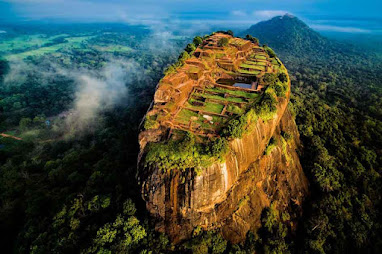Sigiriya, often referred to as the “Eighth Wonder of the World,” is an iconic landmark located in the heart of Sri Lanka. This ancient rock fortress is not only a marvel of engineering and architecture but also a symbol of the rich cultural heritage of the island nation.Exploring Sigiriya: The Majestic Rock Fortress of Sri Lanka
The History of Sigiriya
Sigiriya, which means "Lion Rock," has a history that dates back over 1,500 years. The fortress was built by King Kashyapa in the 5th century CE. According to historical records, Kashyapa chose this site to construct his royal palace and fortress after seizing the throne from his father. The rock’s natural defensive advantages, coupled with its elevated position, made it an ideal location for the king’s stronghold.
The site, however, has a history that predates King Kashyapa. Archaeological evidence suggests that the area was inhabited as early as the prehistoric period, with caves and rock shelters in the vicinity used by Buddhist monks for meditation and religious purposes.
Architectural Marvels
The most striking feature of Sigiriya is the massive rock column that rises nearly 200 meters above the surrounding plains. The fortress complex includes the remains of a palace, gardens, reservoirs, and other structures, all of which are a testament to the ingenuity of ancient Sri Lankan engineers and architects.
At the base of the rock, visitors are greeted by a series of beautifully landscaped gardens, known as the Water Gardens. These gardens are among the oldest landscaped gardens in the world, with symmetrical pools, fountains, and terraces that display advanced knowledge of hydrology and garden design.
As one ascends the rock, they pass through the Boulder Gardens, where large boulders are strategically placed to create a natural yet imposing environment. Further up, the path leads to the Mirror Wall, a polished surface once covered with frescoes depicting celestial maidens. Today, the Mirror Wall is adorned with ancient graffiti, where visitors from centuries past have left their marks in the form of poems and reflections.
The highlight of the ascent is the Lion’s Gate, where two enormous lion paws carved from the rock flank the staircase leading to the summit. This entrance once featured a full lion figure, with its open mouth serving as the gateway to the palace. Though the lion’s head no longer exists, the paws remain, offering a glimpse into the grandeur of the original structure.
Cultural Significance
Moreover, Sigiriya holds a special place in Sri Lankan folklore and history. The story of King Kashyapa, his rise to power, and eventual downfall is a tale of ambition, betrayal, and tragedy that continues to capture the imagination of visitors.
Visiting Sigiriya Today
Today, Sigiriya is one of Sri Lanka’s most popular tourist destinations. Visitors can explore the ruins, admire the stunning views from the summit, and immerse themselves in the history and legends of this ancient fortress. The climb to the top is challenging but rewarding, with panoramic views of the surrounding landscape making it a must-visit for any traveler to Sri Lanka.
In conclusion, Sigiriya is not just a rock; it is a monument to human creativity, resilience, and the enduring legacy of Sri Lanka’s past. Whether you are a history enthusiast, an architecture lover, or simply a traveler seeking adventure, Sigiriya offers a unique and unforgettable experience.



